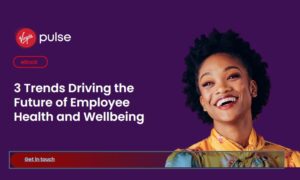Engagement and wellness lessons that must be learned from the past year
2020’s hardships have opened the door to permanently transform the way we work. Follow this guidance to enshrine worker well-being at the core of your business strategy moving forward.

We all learned many painful lessons in 2020.
For execs, perhaps the most pressing takeaway is the stark reminder that employees can make or break any business. Sinking or swimming in 2021 is based entirely on the performance of your “human capital,” but how can you unleash your workers’ full potential in what’s sure to remain a fragmented, volatile landscape?
Deloitte’s 2021 Global Human Capital Trends report offers five definitive trends that wellness pros, HR staffers and communicators should pay close attention to and build their strategies around. Deloitte says the difference between merely “surviving” and ascending into organizational “thriving” boils down to these five steps:
1. Design work for well-being.
Moving forward, it’s essential to weave wellness into work design, according to Deloitte, instead of merely tacking on programs as an ancillary afterthought. That means tailoring a work experience that prioritizes mental health, encourages personal development, crystallizes healthy expectations and bakes in flexibility. If your work experience is anything less than seamless, compassionate, hyper-flexible and supportive, your retention will suffer.
The pandemic has laid bare the importance of not just supporting workers’ well-being, but of making employee wellness the central tenet of corporate productivity. Unfortunately, execs are still a bit slow on the uptake. Deloitte’s research shows that “improving worker well-being” still ranks low on execs’ list of priorities:
As Deloitte writes: “COVID-19 has reminded us of the dual imperatives of worker well-being and work transformation, but executives are still missing the importance of connecting the two. Organizations that integrate well-being into the design of work at the individual, team and organizational levels will build a sustainable future where workers can feel and perform at their best.”
2. Unleash worker potential.
Your workforce is already a reservoir of rich talent. To elicit more passion, energy and motivation in 2021, empower workers to solve problems and dismantle what they perceive as barriers.
Also prioritize creative freedom and agency as you provide “opportunities for professional development, training, mentorship, project participation, networking, promotion, diversity and inclusion,” as Deloitte notes.
There’s nothing wrong with acquiring new talent, but don’t neglect the rock stars in your midst who just need the right motivation to reach new heights. Show these workers you care about their lives and their success with a flood of appreciation and recognition. Provide the resources and support they need. That’s an easy way to unleash employees’ potential.
3. Create “superteams.”
Those departmental siloes must go.
Aside from boosting productivity, improving collaboration between HR, comms, marketing, IT and other departments can bolster trust and engagement. Incorporating advanced tech into your team helps, too.
Deloitte says the “superteams” of tomorrow will strike a balance between people and technology and “use the strengths of both to pursue outcomes at a speed and scale not otherwise possible.”
Deloitte advises viewing emerging tech, such as AI and automation software, as “team members” rather than mere “tools.”
Communicators are at the nexus of any organization. You’re uniquely placed to be a uniter and a bridge builder. 2021 is your time to facilitate more substantive collaboration between departments. By tapping into each other’s expertise, you’ll unearth richer data, foster better conversations, and tell more compelling stories that otherwise would have gone undiscovered.
4. Setting new directions for work and the workforce.
Consistently gathering employee feedback is the key here. It doesn’t do much good to shift directions if your workforce can’t accommodate the new vision.
Deloitte cites Lincoln Financial as an example, which used employee surveys to shape its return-to-work program. Deloitte writes:
“The surveys allowed leaders to identify a range of worker personas reflecting workers’ safety concerns, flexibility desires, and their individual effectiveness in a remote environment. Insights into the roles most affected by virtual work highlighted the potential impacts to productivity, collaboration, and relationship-building. Using these workforce sentiment analyses, Lincoln Financial’s leaders were able to design future ways of working to boost productivity and engagement while maintaining an all-important focus on workforce safety and mental wellness.”
To shape strategy based on post-COVID employee preferences and capabilities, leaders should frequently ask:
- How often are jobs changing and to what degree?
- How ready is our workforce to perform the work of the future?
- Are workers and leaders able to quickly and effectively adapt to constant change?
- What new trends, challenges, and scenarios are leaders and managers being prepared for?
Deloitte also recommends finding answers to these questions:
- How many workers provide direct or indirect services to the organization?
- How healthy is our internal talent market?
- How much capability can we access across our broader ecosystem?
- Which of our workers are at risk of leaving and why?
The report suggests that leaders keen to translate values into action ask these questions:
- How does our organization treat its employees, contractors and service providers of every type?
- Are workers from diverse communities in a position to wield influence in the company?
- How is our culture, workforce and leadership being portrayed externally?
- What signals are we seeing that point to outliers in worker behaviors and norms?
The answers to these questions should inform and shape your engagement and wellness strategies for 2021 and beyond.
5. Building a new work architecture.
Despite the many challenges of 2020, confidence remains high in HR pros.
However, HR is still seen by many as a musty, old-school discipline. The survey states that HR’s highest marks during COVID-19 related to “traditional” responsibilities, such as protecting health and safety, promoting well-being, and increasing communications. There’s nothing wrong with that, but the next challenge for HR leaders is to expand their influence to new, loftier heights. Deloitte goes so far as to say HR’s edict moving forward should be nothing less than “re-architecting work as a whole.”
To make this shift, Deloitte recommends using these tactics:
- Shift the focus from outputs to outcomes.
- Consider re-architecting work to maximize work experience as an ongoing capability.
- Expand the idea of capabilities to include humans and AI.
- Approach workforce development by focusing on human abilities such as analysis and synthesis, problem-solving and social intelligence.
For more guidance on engagement and wellness strategies for 2021, read the rest of Deloitte’s report.







